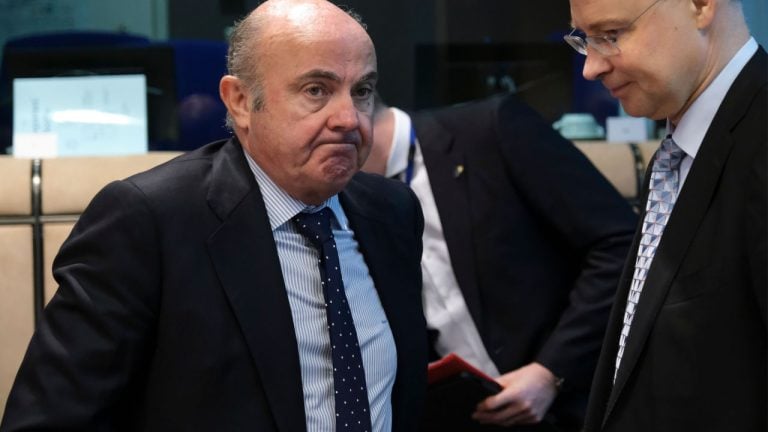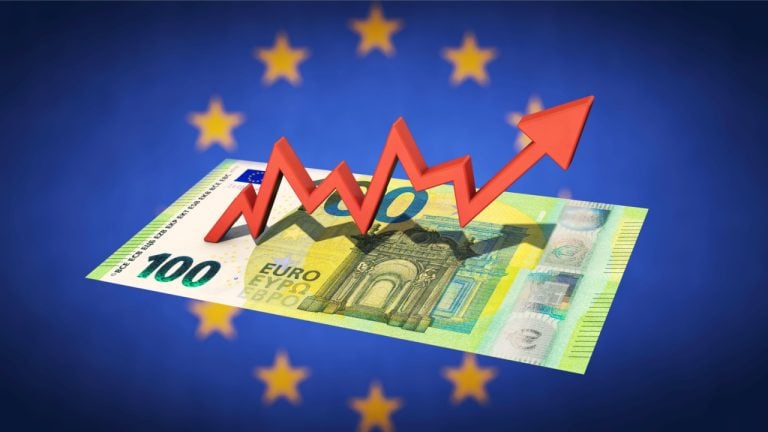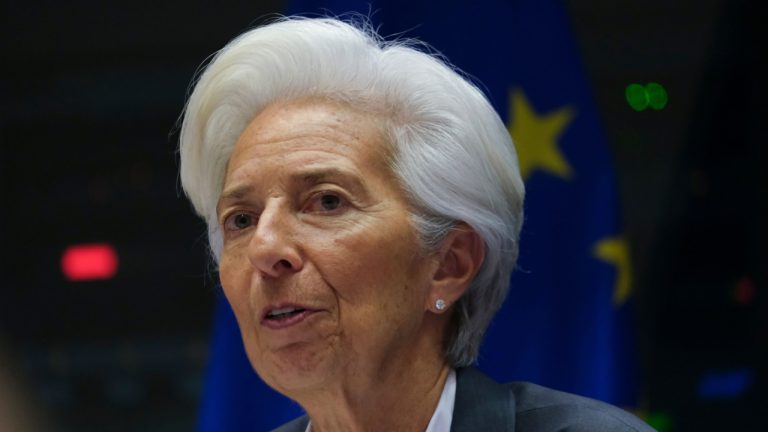 Interest rates will continue to rise while the euro area falls into recession, a high-ranking executive at the European Central Bank (ECB) has indicated. His statements follow the latest rate increase announced by the monetary authority last week and revised projections showing higher than previously expected inflation in Europe ahead. ‘We Have No Choice But […]
Interest rates will continue to rise while the euro area falls into recession, a high-ranking executive at the European Central Bank (ECB) has indicated. His statements follow the latest rate increase announced by the monetary authority last week and revised projections showing higher than previously expected inflation in Europe ahead. ‘We Have No Choice But […]
The ECB is continuing its digital euro investigation with more pieces of the potential system filled in, but no commitment to blockchain technology or even its issuance has been made.
Progress continues on the creation of a digital euro, and the European Central Bank (ECB) has documented it in a second progress report that described design and distribution options recently approved by its governing council. The report considered four crucial issues, roughly in keeping with the timeline the ECB set for itself that tentatively culminates in a decision on whether to transition from the investigation to the realization phase of work in Q3 2023.
The report outlined the roles of the Eurosystem and intermediaries and established that supervised intermediaries would be responsible for all management and user-facing roles in the system. The central banks that make up the Eurosystem would verify and record transactions, correct errors in that process and bear responsibility for their accuracy. Nonetheless, “the digital euro would be designed so that it minimised Eurosystem involvement in the processing of user data,” the report stated.
Offline peer-to-peer transactions with validated digital euros could be settled in a digital storage device and later “verified and recorded through secure elements in hardware devices.”
In January 2023, the @ecb will invite market participants to take part in market research to obtain an overview of options for the technical design of possible digital euro components and services #CBDC https://t.co/c2GIL5Mapg
— Central Bank Payments News (@cbpaymentsnews) December 16, 2022
The ECB is not committed to blockchain technology, the report noted:
“The Eurosystem could rely on either traditional technology, distributed ledger technology or a combination of both for settlement activities. The Eurosystem has not yet taken a decision on the technology that would be best suited for a digital euro.”
Funding and defunding (converting money to and from digital form) should include mechanisms to handle transactions that exceed limits set on digital currency accounts with automatic access to holders’ bank accounts.
Related: European Central Bank chooses Amazon and 4 other firms to prototype digital euro app
A set of pan-euro rules, standards and procedures forming a “scheme” would be necessary for the equitable distribution of the digital euro, the report stated. The goal of the scheme will be that:
“Paying in digital euro should always be an option, irrespective of the entity with which end users open digital euro accounts or wallets and of their country of origin.”
The ECB published its first digital euro progress report in September, after a year of work.
 The European Central Bank (ECB) decided to hike three of its key interest rates by 50 basis points (0.5%) as part of its ongoing war against inflation. The organization stated that further increases are likely to happen “because inflation remains far too high and is projected to stay above the target for too long.” ECB […]
The European Central Bank (ECB) decided to hike three of its key interest rates by 50 basis points (0.5%) as part of its ongoing war against inflation. The organization stated that further increases are likely to happen “because inflation remains far too high and is projected to stay above the target for too long.” ECB […]
EU officials previously rejected an outright ban on crypto mining, but the Markets in Crypto Assets bill could require firms to report any potential environmental impact.
Fabio Panetta, an executive board member of the European Central Bank (ECB), proposed banning crypto assets with a significant environmental impact as part of efforts to address risks.
In written remarks for the Insight Summit at the London Business School on Dec. 7, Panetta said harmonizing taxation around crypto between global jurisdictions could address some of the energy and environment costs around mining and validation. He added that tokens “deemed to have an excessive ecological footprint should also be banned,” referring to proof-of-work assets in a citation.
Panetta added crypto markets were often at risk due to their “incredibly high leverage and interconnections,” citing the collapse of the FTX exchange:
“The inadequate governance of crypto firms has magnified these structural flaws. Insufficient transparency and disclosure, the lack of investor protection, and weak accounting systems and risk management were blatantly exposed by the implosion of FTX. Following this event, crypto-assets may move away from centralised to decentralised exchanges, creating new risks owing to the absence of a central governance body.”
Crypto-assets have become the bubble of a generation, says Executive Board member Fabio Panetta at the @LBS's Insight Summit 2022.
— European Central Bank (@ecb) December 7, 2022
Crypto-assets are not money. Many are just a new way of gambling https://t.co/S3YOJcq9QM
1/4 pic.twitter.com/2VmYAtWGja
The ECB official’s calls for additional regulatory oversight in a ‘Wild West’ crypto market followed the European Parliament Committee on Economic and Monetary Affairs approving the Markets in Crypto Assets bill, or MiCA, in October after extensive discussions. The crypto framework awaits final approval following legal and linguistic checks by EU lawmakers, with many expecting the policy to go into effect starting in 2024.
Related: How blockchain technology is used to save the environment
Associating cryptocurrency transactions and mining operations with environmental concerns has often been a rallying point for global policymakers. In the United States, the New York state legislature voted in favor of a two-year moratorium on crypto miners that use energy generated by fossil-fuel power plants. EU officials previously rejected an outright ban on crypto mining, but MiCA could require firms to report any potential environmental impact.

The total crypto market recovers some lost ground as the contagion risks associated with FTX’s collapse begin to look resolvable.
The total cryptocurrency market capitalization gained 2% in the past seven days, reaching $850 billion. Even with the positive movement and the ascending channel that was initiated on Nov. 20, the overall sentiment remains bearish and year-to-date losses amount to 63.5%.

Bitcoin (BTC) price also gained a mere 2% on the week, but investors have little to celebrate as the current $16,800 level represents a 64% drop year-to-date.
Bankrupt exchange FTX remained at the centerpiece of the newsflow after the exchange hacker continued to move portions of the stolen $477 million in stolen assets as an attempt to launder the money. On Nov. 29, analysts alleged that a portion of the stolen funds were transferred to OKX.
The FTX saga has made politicians shout louder in their calls for regulation. On Nov. 28, the European Central Bank (ECB) president Christine Lagarde called regulation and supervision of crypto an "absolute necessity." The United States House Financial Services Committee Chair Maxine Waters announced that lawmakers would explore the collapse of FTX in a Dec. 13 inquiry.
On Nov. 28, Kraken, a U.S.-based cryptocurrency exchange, agreed to pay more than $362,000 as part of a deal "to settle its potential civil liability" related to violating sanctions against Iran. According to the United States Treasury Department's Office of Foreign Assets Control, Kraken exported services to users who appeared to be in Iran when they engaged in virtual currency transactions.
The 2% weekly gain in total market capitalization was impacted mainly by Ether's (ETH) 7% positive price move. The bullish sentiment also significantly impacted altcoins, with 6 of the top 80 coins rallying 10% or more in the period.

Fantom (FTM) gained 29.3% amid reports that the Fantom Foundation generates consistent profits and has 30 years of runway without selling any FTM tokens.
Dogecoin (DOGE) rallied 26.8% as investors increased expectations that Elon Musk's vision for Twitter 2.0 will include some form of DOGE integration.
ApeCoin (APE) gained 15.6% after the community-led DAO made up of ApeCoin holders launched its own marketplace to buy and sell NFTs from the Yuga Labs ecosystem.
Chainlink (LINK) rallied 11.1% ahead of its staking services beta-version launch on Dec. 6, boosting holders' reward-earning opportunities.
Perpetual contracts, also known as inverse swaps, have an embedded rate usually charged every eight hours. Exchanges use this fee to avoid exchange risk imbalances.
A positive funding rate indicates that longs (buyers) demand more leverage. However, the opposite situation occurs when shorts (sellers) require additional leverage, causing the funding rate to turn negative.

The 7-day funding rate was near zero for Bitcoin, Ether and XRP, so the data points to a balanced demand between leverage longs (buyers) and shorts (sellers).
The only exception was BNB, which presented a 1.3% weekly funding rate for those holding leverage shorts. Although it’s not burdensome to sellers, it reflects investors' unease about buying BNB at the current price levels.
Traders should also analyze the options markets to understand whether whales and arbitrage desks have placed higher bets on bullish or bearish strategies.
Traders can gauge the market's overall sentiment by measuring whether more activity is going through call (buy) options or put (sell) options. Generally speaking, call options are used for bullish strategies, whereas put options are for bearish ones.
A 0.70 put-to-call ratio indicates that put options open interest lag the more bullish calls by 30% and is therefore bullish. In contrast, a 1.20 indicator favors put options by 20%, which can be deemed bearish.

Even though Bitcoin's price failed to break the $17,000 resistance on Nov. 30, there was no excessive demand for downside protection using options. As a result, the put-to-call ratio remained steady near 0.53. The Bitcoin options market remains more strongly populated by neutral-to-bearish strategies, as the current level favoring buy options (calls) indicates.
Despite the weekly price rally on select altcoins and even the 7.1% gain in Ether price, there have been no signs of sentiment improvement according to derivatives metrics.
There's balanced demand for leverage using futures contracts, and the BTC options risk assessment metric did not improve even as Bitcoin's price tested the $17,000 level.
Currently, the odds favor those betting that the $870 billion market capitalization resistance will display strength but a 5% negative move toward the $810 billion support is not enough to invalidate the ascending channel, which could give bulls the much-needed room to eradicate the contagion risks caused by FTX’s insolvency.
This article does not contain investment advice or recommendations. Every investment and trading move involves risk, and readers should conduct their own research when making a decision.
The views, thoughts and opinions expressed here are the authors’ alone and do not necessarily reflect or represent the views and opinions of Cointelegraph.

High-ranking members of the European Central Bank (ECB) say that Bitcoin (BTC) is on the cusp of becoming an irrelevant asset. In a new blog post, ECB officials Ulrich Bindseil and Jürgen Schaaf say that the king crypto’s price drop from its peak of $69,000 set in November 2021 is an indicator that BTC is […]
The post ECB Officials Say Bitcoin (BTC) Is About To Become Irrelevant, Claim Top Crypto on It’s ‘Last Stand’ appeared first on The Daily Hodl.
 On Wednesday, Nov. 30, 2022, a blog post published by the European Central Bank (ECB) discusses bitcoin and the authors Ulrich Bindseil and Jürgen Schaaf seem to believe its “bitcoin’s last stand.” The ECB authors further say that while bitcoin’s price has consolidated and stabilized, the central bank officials remarked that “it is an artificially […]
On Wednesday, Nov. 30, 2022, a blog post published by the European Central Bank (ECB) discusses bitcoin and the authors Ulrich Bindseil and Jürgen Schaaf seem to believe its “bitcoin’s last stand.” The ECB authors further say that while bitcoin’s price has consolidated and stabilized, the central bank officials remarked that “it is an artificially […]
In June, Christine Lagarde said a potential MiCA II framework “should regulate the activities of crypto-asset staking and lending, which are definitely increasing.”
Christine Lagarde, president of the European Central Bank, or ECB, has once again called regulation and supervision of crypto an “absolute necessity” for the EU in the wake of the collapse of crypto exchange FTX.
At a Nov. 28 hearing of the Committee on Economic and Monetary Affairs of the European Parliament, Lagarde cited Facebook’s Libra as an example of the ECB’s involvement which was “helpful to stop some of the players” from engaging with crypto firms. However, she said the situation with FTX — involved with crypto assets as opposed to stablecoins — was more about the “stability and reliability” of the exchange and the ECB needed to step up as a global regulator to address people’s increasing interest in digital assets.
“At least Europe [on the road to crypto regulation] is ahead of the pack,” said the ECB president. “But as I said previously, it’s one step in the right direction. This is not it — there will have to be a MiCA II, which embraces broader what it aims to regulate and to supervise, and that is very much needed.”
Introductory statement by President Christine @Lagarde at the hearing of the Committee on Economic and Monetary Affairs of the European Parliament https://t.co/GKnkOJHh9p
— European Central Bank (@ecb) November 28, 2022
The Markets in Crypto Assets bill, or MiCA, is awaiting final approval following legal and linguistic checks by EU lawmakers. The European Parliament economics committee accepted the MiCA framework in October following trialogue negotiations between the EU Council, the European Commission and the European Parliament. Many expect the policy to go into effect starting in 2024.
Lagarde referred to MiCA II — presumably additional legislation building on the work lawmakers did for the original bill — in June. At the time, the ECB president said the framework “should regulate the activities of crypto-asset staking and lending, which are definitely increasing.”
Related: European Central Bank addresses guidance on licensing of digital assets
European Parliament economics committee member Stefan Berger, one of the proponents of the MiCA framework, also cited the downfall of FTX in advocating for crypto regulation on Nov. 9:
“The FTX case makes it clear what dangers a completely unregulated crypto market and crypto exchanges without licenses entail. We still have a large number of crypto asset service providers whose concept is not understandable. MiCA addresses exactly this problem. With a global MiCA, the FTX crash would not have happened.”
The ECB is currently conducting the two-year investigative phase of its digital euro project, exploring the use of online payments validated by third parties. Some officials within the EU expect to see legislation related to a digital euro in 2023.
 The European Commission is going to present a legislative proposal for a digital euro in the near future, President of European Central Bank Christine Lagarde has indicated. EU legislators are expected to define the new currency’s legal tender status and determine its privacy features. EU Commission to Propose Legislation for Eurozone’s Digital Currency Authorities in […]
The European Commission is going to present a legislative proposal for a digital euro in the near future, President of European Central Bank Christine Lagarde has indicated. EU legislators are expected to define the new currency’s legal tender status and determine its privacy features. EU Commission to Propose Legislation for Eurozone’s Digital Currency Authorities in […]
"Let us envision that better future and build a digital euro that works for all Europeans," said the queen in virtually addressing members of the European Commission.
Máxima Zorreguieta Cerruti, Queen of the Netherlands, said she was encouraged by the work the European Central Bank had accomplished in its efforts to launch a digital euro.
Speaking virtually at a European Commission conference ‘towards a legislative framework enabling a digital euro for citizens and for businesses’ on Nov. 7, the queen said a digital euro could encourage financial inclusion among underserved communities by circumventing roadblocks including transaction fees and documentation requirements. According to the regent, a central bank digital currency, or CBDC, in the European Union could help reduce the cost of remittances, but may require policy reforms and safeguards “to address difficulties and risks.”
“Public sector representatives have a duty to ensure that the financial system is open, inclusive, and responsive to the needs of all groups,” said the queen. “So let us envision that better future and build a digital euro that works for all Europeans.”
As queen consort of the Netherlands since 2013, Máxima has sometimes used her platform to advocate for financial technology as a means of inclusion, specifically citing CBDCs. The Netherlands has been operating under a constitutional monarchy since 1814, with the monarch — in this case, King Willem-Alexander — largely holding a symbolic role as president of the country’s Council of State. Queen Máxima also serves as the United Nations Secretary-General's Special Advocate for Inclusive Finance for Development.
Crypto has a new royal follower. Queen Maxima of the Netherlands has advocated for central bank digital currencies. That, and more stories making headlines in the world of cryptocurrencies pic.twitter.com/jQfkohmB86
— Reuters (@Reuters) October 19, 2022
Related: Blockchain tech offers multiple paths to financial inclusion for unbanked
The Netherlands was the host country for the Bitcoin Amsterdam conference in October, an event which drew in other members of royalty including Prince Philip of Serbia and policymakers including former European Parliament member Nigel Farage. U.S.-based crypto exchange Coinbase also announced its expansion to the Netherlands following regulatory approval from the country’s central bank in September.